|
DAY 3. TUESDAY, AUGUST 13, 2002
Tuesday dawned bright and clear. We were up, having coffee and stirring
around by a little after 6, and had an early breakfast of scrambled eggs,
hashbrowns, cut fruit, biscuits with jelly or jam, juice and more coffee at
6:45 am. Surprisingly, even though we got an early start nobody suggested
that we take a climb up into the well known cave of nautiloid canyon. On
previous trips this had been a fascinating place where it's possible to view
the fossilized remains of prehistoric nautiloid creatures that are distant
relatives of families of the squid and octopus.
Cruising down reasonably calm water below 36 Mile Rapid, the crew made a
couple of inlflatable kayaks available to some of the adventurous passengers.
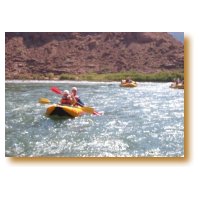
|
Note how clear the water is in 2002.
|
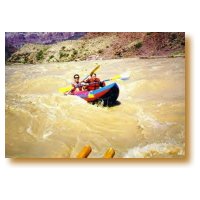
|
Note how muddy the water was in 1997. What a contrast!
|
As we made our way down the calm waters of mile 39 and 40 we noticed the
holes that had been drilled into the canyon walls in preparation for the
construction of Marble Canyon dam. This dam was fortunately blocked by David
Brower, executive director of the Sierra Club. He overcame the strong
influence of Floyd Dominy, commissioner of the Bureau of Reclamation, who
(supported by Senator Carl Hayden) in 1964 began pushing for dams just below
mile 39 in Marble Canyon and near mile 228 in the Grand Canyon. The Marble
Canyon Dam, and the Hualapai or Bridge Canyon Dam very nearly became a
reality. Brower won over a large number of voters by publishing his views in
the Washington Post, the New York Times, the Los Angeles times, and the San
Francisco Chronicle. When the Bureau of Reclamation argued that the dams
would improve the Grand Canyon by making it possible for boaters to get into
side canyons, and closer to the cliffs, Brower responded with his famous
question, "Should we also flood the Sistine Chapel so tourists can get nearer
the ceiling?" The battle is not yet over. The Hualapai Indian Tribe is still
agitating to have the Bridge Canyon Dam built along with a projected casino
in order to attract tourist trade to its reservation.
Gliding past Buck Farm Canyon`and Bert's Canyon we prepared to enter the
first significant test of the day, President Harding Rapid.
Albert (Bert) Loper, the Grand Old Man of the Canyon, was just short of his
80th birthday when he died while rowing 24.5 Mile Rapid in 1949. It is
generally thought that he died of a heart attack, and generally thought that
this was the way he wanted to die. His boat was found lodged on a rock bar
immediately upstream from this unnamed canyon, at mile 41.25, so it was given
the name "Bert's Canyon."
Five years ago Bill and I had successfully run President Harding in a kayak.
It had been a lot of fun. This year two kayaks also ran it with success, and
it was even more fun, because it was a warm and sunny day with almost crystal
clear water. This was a marked improvement over the brown, muddy turbulence
and cold blowing rain off 1997.
Claude S. Birdsey, chief of the USGS 1923 Survey Expedition named this rapid
for President Harding while the group was camped at this site on August 10.
By radio Birdseye learned that August 10 was the date set aside as a memorial
day to President Harding, who had been assassinated on August 2. Therefore
Boulder Rapid was renamed in Harding's honor.
We continued on beyond President Harding Rapid and the grand hairpin turn
around Point Hansbrough. This point was named by Robert Brewster Stanton for
Peter Hansbrough, one of Stanton's boatmen who had drowned at 25 Mile Rapid
in 1889. That was the expedition that had to be absndoned, with Stanton
caching his boat and supplies in Stanton's Cave. In 1990, on his second, and
successful, attempt, Stanton had found Handbrough's body (easily recognizable
by the clothing) washed ashore at this point.
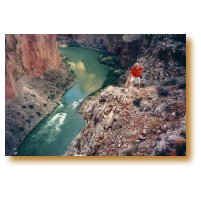
|
This is a view of President Harding Rapid from the top of the Eminance Break.
Point Hansbrough is on the opposite side of the river.
|
Two miles down from Point Hansbrough we came to Saddle Canyon, where we stop
to give those of us who are idiots the chance to hike in the heat up the
canyon. In spite of Rob's adequate warnings, some of our hardier members,
including Phil Roberts accept the challenge. Us smarter ones rested in shade
until they returned for lunch.
The remainder of the afternoon was spent in a leasurely cruise down the
placid waters of the river to Nankoweap Rapid at mile 52.
About 2 miles upstream from the Nankoweap Creek delta we cruised through a
stretch of river with nice campsites on either shore, and when we could see
through the tamarisk trees we were able to notice the relatively soft
mudstone and shale layers of Bright Angel Shale that was appearing at river
level. This layer of rock is the middle layer of the Tonto Group. It is so
soft and crumbly that it is easily eroded, and as it erodes it washes away
back under the harder and stronger layers of Muav and Redwall above it.
Having been undercut, huge chunks of unsupported, heavy Redwall break off,
and roll off down into the canyon. This leaves a broader and broader section
of exposed Bright Angel Shale with a receding cliff of Redwall or Muav and
Redwall above it, and this is how geologists explain the development of the
broad Tonto Platform that lies below the massive Redwall and Muav cliffs and
above the 300 or so foot Tapeats Sandstone cliffs.
As mentioned before these three layers, the Muav Limestone, the Bright Angel
Shale and the Tapeats Sandstone make up the 540 million year old Tonto Group.
By the way, the pretty tamarisk trees, through which we observed the rising
layers of Bright angel Shale, are not native to the Canyon. However, they
have become ubiquitous in the 50 years since they were introduced.. My
friend, Jimmie Davis says that ubiquitous means "They are all over the damned
place."
Tamarisks, native to the Middle East and sections of China, also known as
Salt Cedars. The were introduced into North America in the 1850's, because
botanists had noted that this hardy species would thrive almost anywhere and
in almost any kind of soil. They were brought over here for landscaping and
erosion control. In the Southwest they were planted primarily for erosion
control. Unfortunately they soon got out of control.
Initially it was thought that the introduction of tamarisks would be highly
beneficial for many reasons. For example, agriculturalists were aware of the
writings of Nicholas Culpeper (1616-1654) one of the foremost figures in
herbal medicine for his time. In his book, The Complete Herbal, he wrote, "A
gallant Saturnine herb it is." and pointed out a number of therapeutic uses.
( I get a kick out of this.)
"The leaves, young twigs, bark and/or roots, when boiled in wine produced a
drink that would, stay "…the bleeding of the hæmorrhodical veins," …
excessive menstrual flow, "…jaundice, cholic and spitting up blood,…" It
would also either cure, or reduce the effect of, "… the biting of all
venomous serpents, except the asp;…" This same medicine, if applied
topically, was, "…very powerful against the hardness of the spleen, and the
tooth-ache, pains in the ears, red and watering eyes." Now if you took the
same "decoction" and added some honey, (how much honey was not recorded) he
said that it, "…is good to stay gangrenes and fretting ulcers, and to wash
those that are subject to nits and lice." He goes on to tell us that,
"Alpinus and Veslingius affirm, That the Egyptians do with good success use
the wood of it to cure the French disease, as others do with lignum vitæ or
guiacum; and give it also to those who have the leprosy, scabs, ulcers, or
the like." Since the ashes of burned Tamerisk, "…quickly heal blisters raised
by burnings or scaldings."and "… helps the dropsy, arising from the hardness
of the spleen,…"it is best "…to drink out of cups made of the wood … for
splenetic persons." Oh, and "It is also helpful for melancholy, and the black
jaundice that arise thereof."
Soon it was discovered that these trees consumed a prodigious amount of
water. A mature, large tamarisk is capable of transpiring up to 1100 liters
of water every 24 hours. Small streams have been sucked dry by these pests.
Then other problems became evident. We learned that for good reason this tree
is also known as the Salt Cedar. It can grow in brackish and other mineral
water. It is able to do this because it has the unique capability of
purifying water for its sap by concentrating minerals in it's leaf tips. It
does this everywhere it grows. When it drops its leaves, and the leaves
decay in the soil, they don't enrich the soil as the leaves of other plants
do, but they ruin the soil by making it more salty. As the years go by other
plants find it harder and harder to live in the progressively more
mineralized and salty soil created by the tamarisks. Meanwhile the hardy
tamarisks continue to thrive. Besides all of this, the salinity of the leaves
makes them unpalatable to insects and, so the trees don't provide a very good
habitat for riparian life. Because of this characteristic they have
virtually no enemies to keep them in check.
Each Tamarisk produces up to 600,000 seeds a year; seeds that are blown on
the wind to start new plants. In addition new trees start from shoots
sprouting up from roots of old trees. When conservationists try to clear an
area by cutting them down, often many new shoots sprout up from rootlets left
in the ground, and the end result is an even more dense growth of tamarisks.
So now you know why for nearly half a century agricultural experts have been
trying to find a way to curb the spread of these pesky and stubborn plants.
So far their best efforts have met with a resounding failure.
As we rowed through the reasonably gentle Nankoweap Rapid around the delta
that was created by the huge landslide thousands of years ago we noticed that
there was plenty of camping room on shore, and plenty of space for our boats
on the bank south of the delta. A gigantic earthquake, by the way, had
caused such a landslide that a huge natural dam had been born, creating a
lake that had backed waters all the way back up, and into Stanton's Cave.
Since that time the river has overflowed the earthen dam, cutting a new
channel that arcs to the east side of the river. This is what has formed the
curve in the river and the Nankoweap Rapids.
Please note that Bill Huggins takes exception to my comment that the
Nankoweap Rapids are "reasonably gentle." Billie Prosser, his skipper for
the day, had traded places with him some time earlier in the afternoon,
allowing him to experience handling the oars of the suddenly, to Bill, big
and unwieldy raft. As they approached Nankoweap she continued to enjoy
relaxing while he rowed. He says he made it through the rapids, just barely
missing a big rock, and without spinning around or any one of a number of
things that he quickly realized could have gone wrong. It was much more
difficult, and required a lot more energy than he had realized. I stand
corrected. "Reasonably gentle" as descriptive of rapids in the Canyon
depends on where you are seated, and what your responsibilities are.
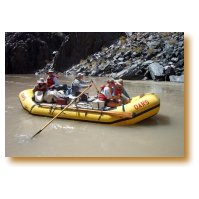
|
Here Bill is back and relaxing as
a passenger the day after his heroic oarsmanship through Nankoweap.
|
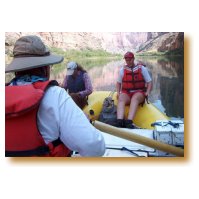
|
Bill rowing Scotty's boat in calm water the first day. This was a shake down for his run through Nankoweap Rapids.
|
We had the boats securely tied, and all of our gear unloaded in plenty of
time to select sleeping quareters, and still have time for leasurely
activities. Many of us hiked the relatively easy trail up to the famous
Anasazi Granaries. With my vertigo, knowing that I would have a good deal of
difficulty climbing back down, I stopped about half way up, and took some
pictures. This was just about the prettiest campsite of the entire trip.
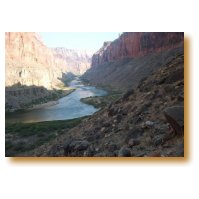
|
Marble Canyon looking south from the trail up to the Anasazi
Granaries at Nankoweap Creek.
|
As we settled down to eat our dinner, Rob Pitagora came over and handed my
lost hearing aid to me. It had been found in the water in the bottom of one
of the boats, and was about to be discarded as a piece of trash (it's a
tiney, in-the-ear model) when Rob recognized it and saved it for me. That's
almost as good as the saga of the ring on our trip with Dories in 1997.
Still more amazing is the fact that once it thoroughly dried out it started
working again, and it is still working. I have had it checked by Dr. Larry
Byals, my hearing aid specialist, and it is just fine.
After dinner we sat around, talking, joking, and reminiscing. We were
becoming more and more relaxed with each other each day, and these evening
bull sessions were developing into a very enjoyable part of the trip.
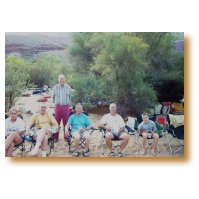
|
Our Group is, from left: Jennifer & Bill Huggins, Bob Groves, (standing)Phil,
Larry and Kevin Roberts.
|
During the night, at 10:10 pm by my watch, there was a meteor or some object
that shot through the sky from roughly South to North that was so bright that
it lit up the camp at least as brightly as a flash of lightning. I have
never seen such a bright object shoot across the sky. All of the campers who
were awake at that time saw it, so I know that it was not my imagination. I
have heard nothing about it on the news since we have returned home. I guess
that it was a much larger than usual meteor. The effect was beautiful and
dramatic. I will always remember it.
|